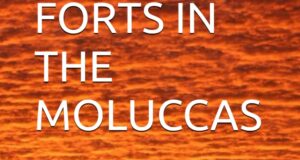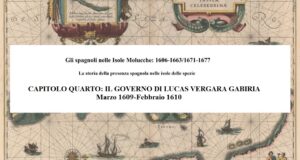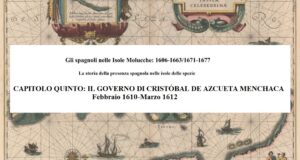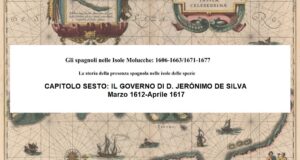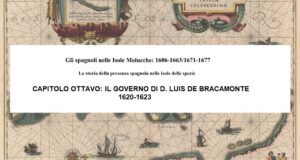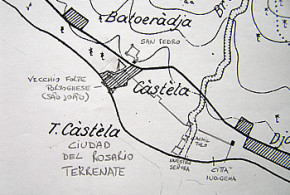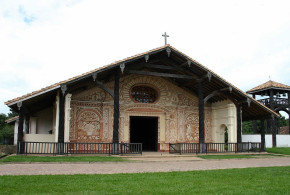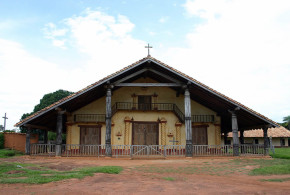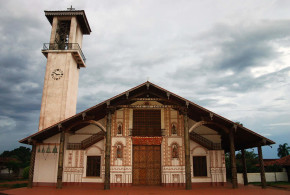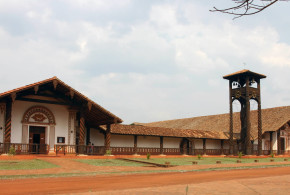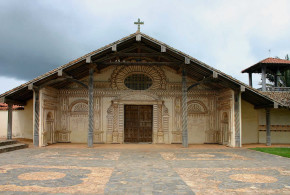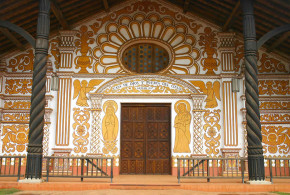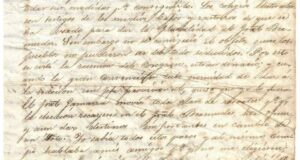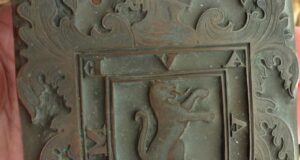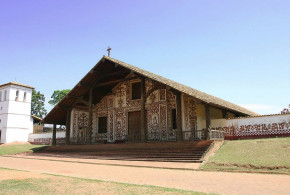This post is also available in:
![]() Italiano
Italiano
Written by Marco Ramerini – 2000-2007/2023
2 – THE EXPEDITIONS OF MAGELLAN AND VILLALOBOS: THE FIRST SPANISH CONTACTS WITH THE ISLAND OF TIDORE AND THE FIRST SPANISH FORT
In the first half of the sixteenth century, upon the arrival of the Europeans, two main kingdoms competed for control of the Moluccas islands, they were the Ternate sultanate and the kingdom of Tidore. The first, more powerful, controlled in addition to the island of Ternate also half of that of Moti, the northern part of the island of Halmahera called Moro, the island of Ambon, the eastern part of Ceram and the north-eastern area of Sulawesi. The kingdom of Tidore, in addition to the island of Tidore, controlled the other half of the island of Moti, the island of Makian, most of the island of Halmahera and the western part of New Guinea. Control over these lands was exercised directly or through vassalage.
Then there were two other minor kingdoms: that of Bacan and that of Jailolo. The kingdom of Bacan, whose capital was on the island of Kasiruta, extended its influence over the archipelago of Bacan and the northern part of Ceram. The kingdom of Bacan was a large producer of sago, a staple food of the Moluccan populations, but was sparsely populated. The kingdom of Jailolo instead had once been the most important of the region, but in 1500 it was in decline and controlled only the northwestern part of Halmahera, Jailolo will be essentially annexed by Ternate and the Portuguese in 1551.
Upon the arrival of the Portuguese, the sultan of Ternate managed to secure their alliance and in 1522 asked and obtained the construction of a Portuguese fortress on his island. The alliance with the Portuguese unbalanced even more in favor of Ternate the power relations with Tidore and on the other hand, Tidore, upon the arrival of the ships of the Magellan expedition, promptly requested the assistance of the Spaniards.1
The Spaniards had the first contacts with the island of Tidore, during the expedition of Magellan. In 1521 the two surviving ships of the expedition, the ‘Trinidad‘ and the ‘Victoria‘, arrived in the Moluccas Islands. The Spanish vessels entered the port of Tidore on November 8, 1521, where they were well received by the king of the island. The ship ‘Victoria‘ remained at Tidore until December 21, 1521, from where it set off again along the Indian Ocean route for Europe, which it successfully reached on September 6, 1522. The ‘Trinidad‘, on the other hand, which needed to be repaired, set sail from Tidore on April 6, 1522, attempting without success to cross the Pacific Ocean, it was forced to return to the Moluccas in October 1522, where the crew was captured by the Portuguese. The Portuguese in the meantime had settled in Ternate where they had built a fortress.2
The first contact with the Tidorese was purely commercial, even if the Spanish, following the request of the king of Gilolo, an ally of Tidore, supplied two pieces of artillery and some soldiers to participate in a punitive expedition against an enemy of the king. The king of Gilolo and that of Tidore declared themselves subjects of the king of Spain, hoping in doing so to balance the excessive power of their bitter enemy, the sultan of Ternate, with Spanish help. This act of submission greatly angered the Portuguese, who had already had commercial relations with Ternate for some years and who considered the entire Moluccas archipelago as their possession.
Upon their departure, the Spaniards promised the king of Tidore that with the next expedition they would build a fortress in Tidore, and for this purpose, they left on their farm, in addition to the merchandise and 5 men3 also 40 ‘bombardadas‘, many ‘beftas‘ and ‘espigardas‘ and various other weapons.4
The promise of building a fort at Tidore was, in fact, fulfilled. The next expedition, under the command of which was originally Loaisa, built a fortress of stone, sand and crushed stone in Tidore. The small fort was built in January 1527 in the main city of the island.
Let’s look in more detail at the events that led to the construction of the first Spanish fort at Tidore. After crossing the Pacific Ocean, the only surviving vessel of the Loaisa expedition, the vessel ‘Victoria‘, commanded by Captain Martin Iñiguez de Carquizano, arrived within sight of the Moluccas and stopped for a few days at Zamafo, a village controlled by Tidore in the island of Halmahera. Following the request of the king of Tidore, the Spanish moved to Tidore, which they sighted on December 31, 1526 at the first light of dawn, they then took the boat to the north-eastern part of the island of Tidore where they spent the night. 5
The following morning, January 1, 1527, the Spaniards headed to the place where the main city of the island was, called ‘Tidori‘. The city was located in the eastern part of the island ‘…el pueblo principal que se llama Tidori está por la parte de leste…’ 6, it had been completely destroyed and burned by the Portuguese at the end of 1526 during the previous war.7 Here the Spaniards arrived at 10 in the morning and immediately met the young king of Tidore (Raja-Mirr) on board of the ship, he confirmed his loyalty to the king of Spain and asked for the help of the Spaniards to counter the Portuguese and their allies from Ternate. The Spaniards helped by the Tidorese, on the very day of their arrival, began the construction of three bulwarks ‘…en este mismo dia comenzamos hacer tres baluartes en tierra para poner artilleria…’ 8 of stone, earth and wood in order to be able to defend itself against a certain imminent attack by the Portuguese.
The sources do not agree on what the fortifications built by the Spaniards must have been like. According to the testimonies, the construction of an all-stone bulwark is reported ‘…fizemos un baluarte a maneira de fortaleza de pedra soomente…’ where the artillery was placed, while on a point the Spaniards had placed two large pieces of artillery.9 Other sources speak of two bulwarks ‘onde chegado & metida a nao dentro no arrecife, mandou fazer na entrada dele dous baluartes de pedra ensosa q artilhou muyto bé com algúa artelharia da nao’ 10 and more ‘…e fez de pedra sequa dous baluartes sobre o arrecife em defensão da nao, e n’elles pôs artelharia, …’ 11 others still talk about a ‘…torre dos castelhanos, a que elles chamauão fortaleza, que tinha huma caua d’agoa derrador; …’. 12 ‘…torre dos Castelhanos, a que chamauão fortaleza, que como disse era cercada de caua’. 13 Diogo do Couto tells us that the Spaniards began to build very quickly two ‘baluartes de pedra ençossa‘ on the edge of the city, while another bastion was built to defend the port. 14
Other testimonies inform us that the bulwark was not only made of stone, but also of earth and wood ‘…y luego en la hora hecimos en tierra un reparo de piedra, y tierra, y madera para poner alguna artilleria para nos defender…’15 ‘se fortificó com fortes tramqueiras y artilleria con nombre de fortaleza’ 16
From the descriptions it is clear in any case that the fortifications that the Spaniards built at the time of the landing in Tidore were two bulwarks, one probably the main one, the one that was called a fortress, was built inside the city of the King near the sea, the other in its vicinity, on a point. Furthermore, later, in June 1528, Hernando de la Torre probably had another defensive bulwark built on the north side of the city. What is certain of this first Spanish fortification in Tidore is that it must have been a work of little importance, given the haste with which it was built. The small fortification was also used as a shelter for goods transported by ships ‘… e ally desembarcaron el artillería, y sus mercaderías y comenzaron á hacer un baluarte para su defensa: y metiéronse en él con todas sus mercaderías y artillería, …’ 17
The day following the arrival of the Spaniards, the artillery and goods that were on board the ship were landed. About half of the ship’s occupants went ashore, while the other half remained aboard because the Spanish feared that the Portuguese would try to sink the ship. There were just over 10018 the Spaniards arrived in Tidore, and the ship ‘Victoria‘ represented the only means at their disposal to be able to attempt the return to Spain. The Spaniards almost immediately had to repel an attack by the Portuguese, who also attacked Tidore several times in the following months. The Portuguese tried by all means to harm the Spanish, the Spanish captain Martin Iñiguez de Carquizano was poisoned by them and died on July 11, 162719, he was succeeded as leader of the Spaniards by Hernando de la Torre. The Spanish actively took part in the struggles between them, Tidore and Jailolo on one side and Ternate and the Portuguese on the other.
Meanwhile in New Spain a new expedition was being prepared for the Moluccas, this fleet, made up of three ships (‘Florida‘, ‘Santiago‘ and ‘Espiritu Santo‘) with 30 cannons and 110 men, had left on October 31, 1527 from Mexican port of Zihuatanejo, the commander of the expedition was Alvaro de Saavedra Ceron. Of this expedition only the ship ‘Florida‘ commanded by Alvaro de Saavedra Ceron arrived in Tidore on March 30, 1528, on board were 45 men who replenished the ranks of the scarce Spanish troops present in Tidore and Jailolo and strengthened the morale of the Spaniards.20 But the failure to discover a return route across the Pacific despite many desperate attempts prevented the Spanish from receiving further aid and communicating with their bases, while on the other hand the Portuguese constantly received reinforcements from Malacca and Goa.
Upon the arrival of the new Spanish ship at Tidore, the fortress of the Castilians appeared as a fortress of stone, sand and rubble (‘piedra, arena y cascajo‘) two arms high and six feet thick, it was armed with a cannon, a ‘culebrina’, two ‘sacres’ and many other pieces of iron artillery, a good quantity of ‘escopetas’ and ‘ballestas’, it appeared quite well stocked with artillery and the troops were well armed. 21
In addition, other defensive works were prepared by the Spaniards: In a report to the king of Spain written by Tidore on June 11, 1528, Hernando de la Torre indicated that in order to better defend the city it was necessary to build a bulwark at an entrance to the city of Tidore, he for this purpose had placed in that target 20 soldiers led by Diego de Ayala and with 5 or 6 artillery pieces. 22
Despite the construction of these successive defense works, the Spanish fort was taken by the Portuguese in October 1529. The Portuguese could not have chosen a better moment for the attack, in fact, the Spanish had divided their forces by sending 18 soldiers along with the troops of Tidore for a punitive expedition in the northern part of Halmahera. A small garrison of 37 Spaniards remained in defense of the city of Tidore of which only 25 were able to take up arms, the number of Tidore troops remaining in defense of the city was also reduced.
The city of Tidore was attacked on 28 October 1529 by the Portuguese and their Ternatese allies, here the Spanish initially attempted resistance along the city wall and along the bulwark that had been built at the entrance to the city, but then saw the superior number of the Portuguese and their allies, were forced to retreat within the walls of their fortress. The Portuguese burned the whole city of Tidore and laid siege to the Spanish fortress. The surrender was requested by the Portuguese, under penalty of killing all the defenders of the fortress, the Spaniards commanded by Hernando de la Torre, after several discussions, agreed to abandon the fortress on the condition of being transferred to the village of Zamafo on the island of Halmahera. The Portuguese also imposed a ban on them from returning to the Moluccas ‘…no fuese en ninguna de las cinco islas de clavo‘. Captain Fernando de la Torre left Tidore for Zamafo together with 23 Spanish soldiers, while another 12 remained with the Portuguese and entered their service.23
In the fortress and in the farm that was inside the Spanish fortress, the Portuguese, in addition to various merchandise, confiscated many weapons including 6 large metal artillery pieces, 25 iron artillery pieces (‘…versos y falcones…‘) , 4 large pieces, 4 ‘pasamuros‘, 8 ‘falcones‘ and other ‘tiros pequeños‘.24
After the Portuguese conquest of the Spanish fort of Tidore, it seems that some Portuguese soldiers remained to garrison the island ‘… habia quedado gente de portugueses en Tidori…’ 25 Castanheda also mentions that some Portuguese remained in Tidore to teach the Tidorese ‘os nossos costumes‘ and to prevent an alliance between Tidorese and Spaniards from happening again in the future. 26
As we have seen this first fortress built by the Spanish at Tidore was a very simple construction of dry stone wall, probably just a small defensive bastion: ‘Los portugueses nos echaron por armas de Tidori, donde teniamos una fortaleza de piedra seca y toda l’artillería y hacienda que teniamos para nuestro mantenimientos, y dos fustas…’ 27 ‘…la fortaleza que tenian hecha los castellanos á manera de baluarte’ 28 The Spanish held the fort of Tidore for almost three years from January 1st, 1527 to October 28, 1529. The few Spaniards who remained with Hernando de la Torre remained for a few more years in Jailolo, from where they were then embarked between 1534 and 1535 towards the India and then to Spain. 29
The survivors of the Grijalva expedition arrived in the Moluccas a few years later, in 1537, but they immediately surrendered to the Portuguese and had no influence on power relations in the Moluccas.30
The last Spanish contact with the Spice Islands before the union with Portugal was with the expedition led by Ruy López de Villalobos. The destination of the expedition, by virtue of the 1529 agreement, was the unspecified spice islands not yet occupied by the Portuguese. Villalobos departed from Mexico on November 1, 1542 with 4 ships, a galliot and a brigantine.
After a failed attempt to colonize the island of Sarragan, the remnants of the expedition reached Gilolo where they were well received by the king, who offered them permission to build a fortress. Subsequently the king of Tidore also went to Gilolo31 where he visited the Spaniards and a contract of alliance was again stipulated between Spain, Tidore and Gilolo. A group of 60 Spanish soldiers commanded by don Alonso Manrique was sent to Tidore. Later the other Spanish troops also moved to the island.32
The Spaniards of Villalobos helped their allies against their enemies in several battles, but always avoided fighting against the Portuguese, maintaining friendly relations with them, and exchanging visits, which made the king of Tidore suspicious. The king of Tidore in August 1545, to defend and protect himself, had a dry stone fortress built on the top of a hill ‘… hizo fortalezer un peñol y ençima del hizo una fortaleza de piedra seca, para se recojer alli si neçessario fuese, …’. 33 The Spanish repeatedly tried to establish contacts with New Spain, but all the ships sent were forced to return to the Moluccas without having found a return route to America, this caused deep discouragement in the Spaniards, who began to desert and go over to the side of the Portuguese. After this the Spanish were forced to negotiate a surrender with the Portuguese and abandon Tidore, they had been in Tidore from March 1544 to November 1545.34 In February 1546 the survivors of the Villalobos expedition left the Moluccas aboard Portuguese ships. Villalobos will die in Ambon on his return journey to Spain.35
INDEX:
1 – The Spanish fortresses on the island of Tidore 1521-1663: introduction
3 – The Spanish expeditions to the Moluccas after the union with Portugal
4 – The Spanish forts of the island of Tidore 1606-1663
5 – The defenses of the city of the King of Tidore: Lugar Grande De El Rey (Soa Siu)
6 – Fuerte de los portugueses (Fortaleza dos Reis Magos)
7 – Tohula Fort, Santiago de los Caballeros
8 – Sokanora Fort
9 – Marieco Fort
10 – Tomanira Fort
11 – Chobo Fort
12 – Fort of Rume
13 – Puli Caballo Island
14 – Captains of Tidore (Fortress of Santiago de los Caballeros)
NOTES:
1 Jacobs, “Documenta Malucensia I, 1542-1577” (Roma, 1974) 3*-4*
De Silva, C. R. “The Portuguese and the trade in cloves in Asia during the sixteenth century” In: Various authors “An expanding world, vol. 11” 261.
2 The Portuguese fort was founded by António de Brito in June 1522, the first stone of the fortress was laid for the feast of St. John the Baptist, June 24, 1522, the fortress was called “São João Bautista de Ternate“. The fortress was built by the Portuguese, where it was the main city of the Ternate sultanate (south of the island), one league from the main port of the island, called Talangame, where the ships were anchored.
3 They were: Juan de Campos de Escribano, Luis del Molino, Alonso de Cota Ginovés, Diego Arias and Maestre Pedro Lombardero. See: Fernanadez de Navarrete “Colección de los viajes, vol. 4” 98; and also “Declaraciones que dieron en Valladolid Gonzalo Gomez de Espinosa, Ginés de Mafra, y Leon Pancaldo, sobro los acontecimientos de la nao Trinidad en las Malucas” Document n°40 in:Fernanadez de Navarrete “Colección de los viajes, vol. 4” (Madrid, 1837) 381
According to Castanheda the men who remained in Tidore numbered 10-12 men. See: Lopes de Castanheda “História do descobrimento e conquista da Índia pelos portugueses” Livro VI, cap. 5, 160
While according to Antonio Galvao there were 4 men. See: Galvão “História das Molucas” 205
4 Lopes de Castanheda “História do descobrimento e conquista da Índia pelos portugueses” Livro VI, cap. 10, 169; Fernanadez de Navarrete “Colección de los viajes, vol. 4” 98
5 “Derrotero del viage y navegacion de la armada de Loaisa…” Document n° 14 in:Fernanadez de Navarrete “Colección de los viajes, vol. 5” 285
6 “Derrotero del viage y navegacion de la armada de Loaisa…” Document n°14 in: Martin Fernanadez de Navarrete “Colección de los viajes y descubrimientos que hicieron por mar los españoles, vol. 5” (Madrid, 1837) 286
7 According to a Portuguese slave who had fled to Zamafo, the destruction had taken place a few days before the arrival of the Spanish ships. For this episode see: Castanheda “História do descobrimento e conquista da Índia pelos portugueses” Livro VII, cap. 39, 438
8 “Relacion escrita y presentada al el Emperador por Andres de Urdaneta …” Document n°26 in:Fernanadez de Navarrete “Colección de los viajes, vol. 5” 412
9 “Carta de Pedro de Montemayor escrita desde Cochin al Rey de Re del Portugal…, Cochin 14 Janeiro 1533” Document n°19 in: Fernanadez de Navarrete “Colección de los viajes, vol. 5” 343
10 Lopes de Castanheda “História do descobrimento e conquista da Índia pelos portugueses” Livro VII, cap. 42, p. 441
11 Gaspar Correa “Lendas da India” vol. III, 175
12 Gaspar Correa “Lendas da India” vol. III, 360
13 Lopes de Castanheda “História do descobrimento e conquista da Índia pelos portugueses” Livro VIII, cap. 6, 569
14 Diogo do Couto “Da Asia” Decada IV, parte 1, 190
15 “Derrotero del viage y navegacion de la armada de Loaisa…” Document n°14 in: Fernanadez de Navarrete “Colección de los viajes, vol. 5” 286
16 “Al Rey de Portugal, Alfonso Mexia, Cochin 30 diciembre 1528” Document n°13 in: Fernanadez de Navarrete “Colección de los viajes, vol. 5” 240
17 “Declaracion de Juan de Mazuecos” Documento n°21 in: Fernanadez de Navarrete “Colección de los viajes, vol. 5” 363
18 105, 115, 116, 117 (Galvão “História das Molucas” p. 215), 123, 133 depending on the testimonials
19 He was buried in the church of ‘Nossa Senhora do Rozairo‘ evidently the name of the chapel erected by the Spaniards in Tidore. “Carta de Pedro de Montemayor escrita desde Cochin al Rey de Re del Portugal…, Cochin 14 Janeiro 1533” Document n°19 in: Fernanadez de Navarrete “Colección de los viajes, vol. 5” 345
20 Fernanadez de Navarrete “Colección de los viajes, vol. 5” 94-113
21 “Relacion que presentó en Madrid el Año 1534 Vicente de Nápoles sobre los sucesos de la armada de Saavedra …” Document n°37 in: Fernanadez de Navarrete “Colección de los viajes, vol. 5” 486
Fernanadez de Navarrete “Colección de los viajes, vol. 5” 113
22 “Derrotero del viage y navegacion de la armada de Loaisa…” Document n°14 in: Fernanadez de Navarrete “Colección de los viajes, vol. 5” 308
Fernanadez de Navarrete “Colección de los viajes, vol. 5” 123
23 “Relacion de Hernando de la Torre de lo ocurrido en las Molucas contra los portugueses de la isla de Terrenate, desde su ingreso en aquellas islas hasta fin del año 1533” Document n°20 in: Fernanadez de Navarrete “Colección de los viajes, vol. 5” 353-360 Gaspar Correia “Lendas da India” vol. III, 359
24 “Declaracion de Francisco de Paris, marinero de la nao Victoria …, 25 otubre 1536” Document n°23 in: Fernanadez de Navarrete “Colección de los viajes, vol. 5” 375
Fernanadez de Navarrete “Colección de los viajes, vol. 5” 133
25 Fernanadez de Navarrete “Colección de los viajes, vol. 5” 356
26 Lopes de Castanheda “História do descobrimento e conquista da Índia pelos portugueses” Livro VIII, cap. 7, 571
27 “Carta de Hernando de la Torre a D. Alvaro de Zuñiga, Gilolo, marzo 1532” Document n°18 in:Fernanadez de Navarrete “Colección de los viajes, vol. 5” 337
28 “Declaracion de Juan de Mazuecos” Documento n°21 in: Fernanadez de Navarrete “Colección de los viajes, vol. 5” 364
29 Fernanadez de Navarrete “Colección de los viajes, vol. 5” 150-155
30 On the vicissitudes of this expedition see: Galvão “História das Molucas” 307-317
31 According to Couto, it was the Spaniards who asked the king of Tidore for permission to move to Tidore. Diogo do Couto “Da Asia” Decada V, parte 2, 406-407
32 P. Pablo Pastells “Historia general de las islas Filipinas, 1493-1572” vol. I, clxxi In: D. Pedro Torres y Lanzas “Catalogo de los documentos relativos a las islas Filipinas existentes en el archivo de Indias de Sevilla. Procedido de una História General de Filipinas, por el P. Pablo Pastells, S. J.” (Barcelona, 1925-1936)
33 “Relacion de Garcia de Escalante Alvarado” AGI: Patronato,23,R.10 in: Consuelo Varela “El viaje de don Ruy López de Villalobos a las islas del Poniente, 1542-1548” (Milano, 1983) 143-144
Pastells “Historia general de las islas Filipinas, 1493-1572” vol. I, clxxvi
34 The agreement between the Spanish and the Portuguese was signed on November 4, 1545. “Carta de fray Geronimo de Santisteban a don Antonio de Mendoza, de Cochin, en la India de Portugal a 22 de enero de 1547” AGI: Patronato,20,R.12 in: Consuelo Varela “El viaje de don Ruy López de Villalobos a las islas del Poniente, 1542-1548” (Milano, 1983) 30
35 Pastells “Historia general de las islas Filipinas, 1493-1572” vol. I, clxxxvi, cxciii
Ciríaco Pérez-Bustamante “La expedición de Ruy López de Villalobos a las Islas de Pacífico” In: Various authors “A viagem de Fernão de Magalhães e a questão das Molucas. Actas do II colóquio Luso-Espanhol de História Ultramarina” (Lisbona, 1975) 611-626
This post is also available in:
![]() Italiano
Italiano
 Colonial Voyage The website dedicated to the Colonial History
Colonial Voyage The website dedicated to the Colonial History


